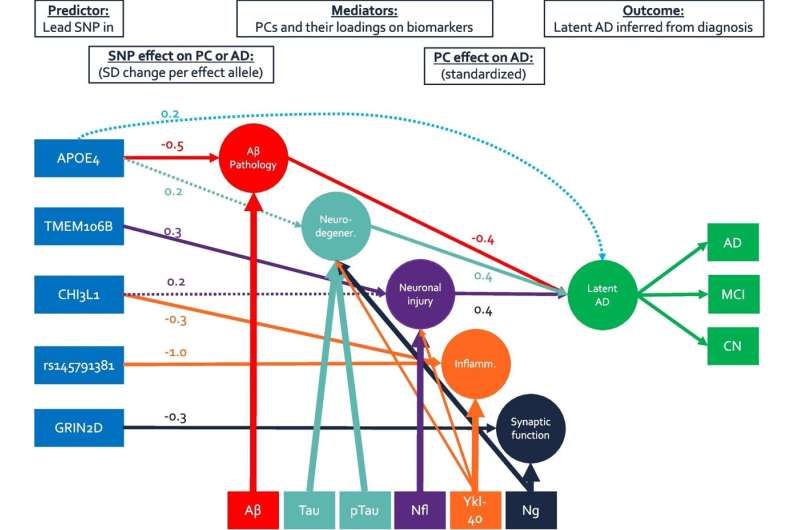This article has been reviewed according to Science X's editorial process and policies. Editors have highlighted the following attributes while ensuring the content's credibility:
fact-checked
peer-reviewed publication
proofread
New Alzheimer's disease pathways identified

Dementia, which includes Alzheimer's disease, currently affects around 1.8 million people in Germany. The exact cause has not yet been clarified, but genetic factors play a significant role in the development of the disease. Most previous analyses aimed at the identification of novel Alzheimer's genes used, a "case-control design."
"With this conventional and highly simplistic analysis strategy, a vast amount of clinical information is lost that can be valuable for elucidating new disease mechanisms," says Prof. Dr. Lars Bertram, head of the Lübeck Interdisciplinary Platform for Genome Analysis at the University of Lübeck and project leader of the now published study.
"In our latest investigation of almost 1,000 individuals, we therefore combined the data from six different Alzheimer's biomarkers and were thus able to map the disease pattern much more accurately in the subsequent genetic analyses."
The study is published in the journal Genome Medicine.
One of the findings suggests a reduced expression of GRIN2D, a receptor of the brain messenger glutamate, in Alzheimer's disease and other neuropsychiatric disorders. "This probably leads to an impairment of the function of the synapses, i.e. the connections by which nerve cells in the brain communicate with each other," says Bertram.
By combining the Alzheimer's biomarkers, it was possible to carry out additional downstream analyses that would not have been possible using a conventional study design.
"In this context, we would like to highlight so called mediation analyses, a statistical method to uncover a possible causal involvement of the investigated biomarkers in the disease," explains Dr. Alexander Neumann from the Erasmus University Medical Center in Rotterdam, and lead author of the study. "These analyses suggest that there are at least two main pathways involved in Alzheimer's disease."
The research team found that one pathway acts through the effects of so-called amyloid and tau proteins, which has been known for a long time and is mediated by the Alzheimer's risk gene APOE, which has been known for decades. The second important pathway is largely based on the reaction of the immune system, which is caused, among other factors, by the effects of the genes TMEM106B and CHI3L1, which play a role in the transport of cellular components and the regulation of inflammatory responses.
Moreover, the analysis of the X chromosome (which determines the biological sex) as well as genome-wide analyses stratified by sex provided new insights into the previously unexplained difference in the frequency of Alzheimer's disease between men and women.
"The results of this part of the study show that certain genes lead to measurable effects in relation to Alzheimer's biomarkers only in men or only in women," says Dr. Olena Ohlei from the Lübeck Interdisciplinary Platform for Genome Analytics and second first author of the study. "Some findings even suggest opposite effects in men compared to women, i.e. that certain genes increase the risk of Alzheimer's disease in women but decrease it in men, or vice versa." Further studies are needed to find an explanation for this.
Overall, the published work shows new ways to help to better understand the causes of Alzheimer's disease. " Ideally, it shows that the method of multivariate, i.e. combined analysis of biomarkers, which we used for the first time, can also improve the diagnosis of Alzheimer's disease or may even allow it to be diagnosed at an earlier stage," Bertram summarizes the findings.
"For this, however, our results must first be validated in independent samples, as is common in science."
More information: Alexander Neumann et al, Multivariate GWAS of Alzheimer's disease CSF biomarker profiles implies GRIN2D in synaptic functioning, Genome Medicine (2023). DOI: 10.1186/s13073-023-01233-z





















